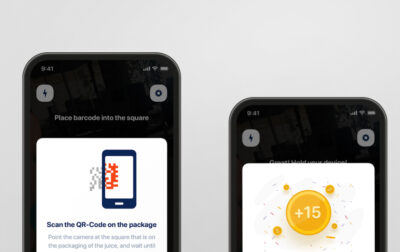Backend for Mobile Apps: a Guide on Choosing a Tech Stack for Mobile Development
01.
Having a potentially profitable software development idea is a good start, but figuring out how to bring it to life might seem like an obstacle for the majority of business owners.
While performing market analysis and finding your software development team is understandable, thanks to a variety of options out there, you will likely face endless unanswerable questions during the process. And we bet some of them are already in your mind. Or why else would you be reading this article?
Long story short, let’s explore mobile backend tech solutions you may consider for your future project so you kick off the development successfully.
02.
Before Moving On, Let’s Quickly Learn What a Mobile App’s Backend Means
Mobile app backend is the part of the software running on a server instead of the device itself. The backend is responsible for storing and managing app’s data, authenticating users, analyzing data and communicating with other systems within and outside the app.
It is important to mention that mobile backend takes many forms depending on the purpose. It could be a server running on a cloud service, an API or a database.
Okay, What are the Options?
03.
Software as a Service (SaaS)
SaaS is a term used to describe a software delivery model where the software is hosted by a third-party provider and made available to customers.
SaaS typically goes with a subscription fee either on a monthly or annual basis. This could be the easiest option for mobile backend though there is a downside to consider – it is almost impossible to find a ready SaaS solution that will perfectly meet all your project’s requirements.
So, if you are opting for a SaaS solution, we recommend combining several solutions. These could be:
- WordPress – achieved through an API request based on WordPress structure and database structure;
- Mailchimp;
- Shopify – best for E-commerce platforms;
- Dropbox.
04.
Mobile Backend as a Service (MBaaS)
MBaaS is another option for mobile development since it can automate the backend side of the software and helps to establish the cloud infrastructure.
MBaaS solutions could also offer other useful features, including user management, push notifications, email alerts, various social media integrations, advanced file storage, and several payment options.
One of the key reasons for choosing MBaaS is its ability to build the front end through APIs and SDKs without worrying about the underlying backend and infrastructure. Some examples of MBaaS solutions you may want to consider are:
- Back4app;
- Firebase;
- AWS Amplify;
- Apple Cloudkit.
05.
Custom Backend Solutions
When having complicated software development or if you just want the backend solution to perfectly cover all requirements, choose custom backend solutions. This path is known to be the most powerful and flexible, allowing teams to gain complete control over all features that cannot be implemented with SaaS or MBaaS solutions.
The only drawback of a custom backend is that it requires longer to be developed. While the timeline with custom solutions will definitely be longer, choosing the right tech stack could help you save both the time and money required. These are the two most popular programming languages for mobile backend in 2024:
- Java is known for robustness and compatibility, and it has a large developer community, making it a natural choice for building Android apps. Its expensive libraries and object-oriented approach make it a great choice for creating complex and feature-rich apps.
- C# (with ASP.NET) is a versatile programming language with a range of features and capabilities, like strong typing, garbage collection, seamless integration with the .NET ecosystem and scalability. It is known to be one of the best solutions for mobile backend thanks to its simplicity, readability, and performance.
However, there are more options you may want to consider. These include Ruby, PHP, Python, Node.js and Golang.
With years of expertise, Touchlane excels in crafting mobile backend solutions using the robustness of C# and Java programming language, solving any, even the most non-trivial problems. For example, our team built an app called Color Therapy.
Given the key goal for an app to handle growing user loads and vast functionality efficiently, our specialists developed a three-subsystem backend architecture: Content (leveraging Azure CDN), Social (REST API backend), and Voting (scheduled workers for contest logic).
Explore more details on the development process and our end solution
06.
Factors Affecting the Backend Tech Stack Choice
Knowing the most popular backend for mobile app tech stack solutions isn’t enough. Apps differ, and tech stack also does. We’ve listed the main aspects you should focus on when selecting utilities for the backend development:
Functionality
Needless to say, the more complex the functionality you plan, the more sophisticated the backend technology stack is.
To develop comprehensive functionality, you may consider trusted cloud providers such as Google Cloud Platform (GCP) and AWS Services for both iOS and Android platforms. These services provide a broad set of tools for backend creation and third-party integrations.
Speaking of the third-party services, they are a win-win option to use to expand your in-app functionality without time and money losses.
For example, you want your app to have such features as online maps to check geolocation, so it will be much more efficient to set integrations with already available third-party platforms like Google Maps and Mapbox than to develop and design your own map with your in-house API yourself.
Scalability Needs
The majority of business owners plan to develop and expand their products in the future by adding new features or adjusting them to new platforms as the market changes.
If you are pursuing the same goals, your backend infrastructure should be scalable in order to handle the traffic growth and heavy loads.
As such, you need to be quite selective when choosing the right database for your project. For high-load systems with a large insert rate, it is better to use NoSQL databases like MongoDB or DynamoDB because they are easy to scale and can be stored on multiple servers in the cloud.
Another condition for easy scaling is the implementation of the REST architecture with stateless API, which doesn’t store sessions. However, data is stored on the server for as long as you like, and it can be scaled by increasing the number of instances.
Security Matters
If we are talking about something that you should always focus on is your product security. Mobile apps often demonstrate vulnerabilities to authentication issues due to the wrong choice of security mechanisms or the wrong use.
We recommend selecting modern security protocols like OAuth 2.0, helping to ensure that the data between a server and browsers remain private, especially when it comes to fintech & banking apps.
Another common security issue regards HTTP, as it may either not exist or have expired certificates.
As the certificates are issued for a certain period of time, users may forget to renew them.
This issue is solved by automatic certificate renewal, which is usually covered by load balancers from the chosen cloud provider, as they automatically renew the certificates.
Budget Expectations
Luckily, some backend utilities can be open-source and have free plans. But it’s a common case when you need a paid subscription to access some advanced functionalities.
For instance, a paid subscription in services like Firebase usually depends on the amount of data stored and transferred, memory provisioned, tests run, etc. As such, keep in mind some extra expenses and always specify your budget limits for the team.
Industry
Your business size and industry type can also affect the choice. If the application is defined for some enterprise and involves the use of highly secured data (e.g., in fintech & banking industries), you need to choose statically typed languages like Java.
It is much easier to maintain than dynamic languages, and it has a large ecosystem with good libraries, documentation, and security protocols.
(Note: Apart from the factors mentioned above, the choice of backend development technologies may also depend on the expected timeframes, competition on the market, development team proficiency, location of the team, etc.).
07.
Let’s Wrap it Up
Choosing the right backend technology stack is halfway to the success of your mobile product. So, we recommend thoroughly considering all the factors and weighing the pros and cons of different backend solutions. This will allow you to avoid pitfalls and ensure a bug-free application as an outcome.
Irrespective of how far you moved with the mobile app development already, Touchlane experts can get you covered. If any questions arise, we will help you find the best solution and advise you on either the mobile app development stack or the full cycle of development.
Just drop us a line!
RELATED SERVICES
CUSTOM SOFTWARE DEVELOPMENT
If you have an idea for a product along with put-together business requirements, and you want your time-to-market to be as short as possible without cutting any corners on quality, Touchlane can become your all-in-one technology partner, putting together a cross-functional team and carrying a project all the way to its successful launch into the digital reality.
If you have an idea for a product along with put-together business requirements, and you want your time-to-market to be as short as possible without cutting any corners on quality, Touchlane can become your all-in-one technology partner, putting together a cross-functional team and carrying a project all the way to its successful launch into the digital reality.
We Cover
- Design
- Development
- Testing
- Maintenance











